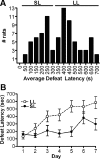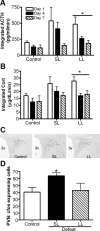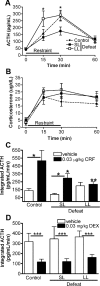Individual differences in reactivity to social stress predict susceptibility and resilience to a depressive phenotype: role of corticotropin-releasing factor
- PMID: 20160137
- PMCID: PMC2850230
- DOI: 10.1210/en.2009-1026
Individual differences in reactivity to social stress predict susceptibility and resilience to a depressive phenotype: role of corticotropin-releasing factor
Abstract
Previous social stress exposure is a common risk factor for affective disorders. However, factors that determine vulnerability or resiliency to social stress-induced psychopathologies remain unclear. Using a rodent model of social stress, the present study was designed to identify putative neurobiological substrates that contribute to social stress-induced psychopathology and factors that influence or predict vulnerability. The resident-intruder model of defeat was used as a social stressor in adult male Sprague Dawley rats. The average latency to assume a subordinate posture (signaling defeat) over seven daily defeat exposures was calculated and examined with respect to endpoints of hypothalamic-pituitary-adrenal activity, components of the corticotropin-releasing factor (CRF) system, and behaviors that are relevant to human depression. In the present studies, a bimodal distribution emerged in an otherwise homogeneous population of Sprague Dawley rats such that 42% of rats exhibited short defeat latencies (<300 sec), whereas 58% of rats resisted defeat and exhibited longer latencies (>300 sec). These two phenotypes were associated with distinct endocrine and behavioral profiles as well as differences in components of the CRF system. Notably, the short-latency subpopulation exhibited hypothalamic-pituitary-adrenal dysregulation and behavior similar to that observed in melancholic depression. Examination of components of the CRF system suggested that proactive behavior in resisting defeat exhibited by long-latency rats was associated with decreased efficacy of CRF. Together, these data suggest that inherent differences in stress reactivity, perhaps as a result of differences in CRF regulation, may predict long-term consequences of social stress and vulnerability to depressive-like symptoms.
Figures





References
-
- Brown GW, Prudo R 1981 Psychiatric disorder in a rural and an urban population: 1. Aetiology of depression. Psychol Med 11:581–599 - PubMed
-
- Heim C, Mletzko T, Purselle D, Musselman DL, Nemeroff CB 2008 The dexamethasone/corticotropin-releasing factor test in men with major depression: role of childhood trauma. Biol Psychiatry 63:398–405 - PubMed
-
- McEwen BS, Stellar E 1993 Stress and the individual. Mechanisms leading to disease. Arch Intern Med 153:2093–2101 - PubMed
-
- Krishnan V, Han MH, Graham DL, Berton O, Renthal W, Russo SJ, Laplant Q, Graham A, Lutter M, Lagace DC, Ghose S, Reister R, Tannous P, Green TA, Neve RL, Chakravarty S, Kumar A, Eisch AJ, Self DW, Lee FS, Tamminga CA, Cooper DC, Gershenfeld HK, Nestler EJ 2007 Molecular adaptations underlying susceptibility and resistance to social defeat in brain reward regions. Cell 131:391–404 - PubMed
-
- Becker C, Zeau B, Rivat C, Blugeot A, Hamon M, Benoliel JJ 2008 Repeated social defeat-induced depression-like behavioral and biological alterations in rats: involvement of cholecystokinin. Mol Psychiatry 13:1079–1092 - PubMed
MeSH terms
Substances
LinkOut - more resources
Full Text Sources
Medical

